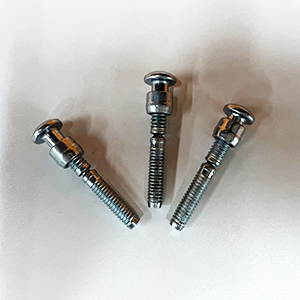Ring groove rivets refer to a special type of rivet. Ring groove rivets are divided into large diameter ring groove rivets, small diameter ring groove rivets, complete ring groove rivets and short tail rivets. Ring groove rivets are made of high quality carbon steel, with high riveting strength and firmness. Reliable. It is characterized by good vibration resistance, wide application and convenient construction.
Ring groove rivets are used to rivet two structural parts into a whole. It consists of two parts: a rivet and a nail sleeve. The rivet consists of a nail rod and a nail sleeve. When riveting, first insert the rivet into the nail hole of the connecting piece, and then remove it from the rivet. On the other side of the connector, put the nail sleeve on the ring groove of the rivet working section, and then use a special tool - the gun nozzle to put the nozzle of the pneumatic ring groove rivet on the ring groove of the rivet clamping section, and press the nozzle on The end face of the nail sleeve, and then pull the trigger of the gun. The rivet force will tighten the nail rod in the ring groove of the rivet clamping section until it breaks. At this time, the inner wall of the nail sleeve squeezes into the ring groove of the rivet working section to form a new rivet head. , thereby riveting and fastening the connected parts. It has the characteristics of easy operation, high efficiency, low noise, and good earthquake resistance, so it is used in various fields such as vehicles, ships, aviation, mechanical equipment, and building structures.
What should you pay attention to during operation? Precautions for operating ring groove rivets:
(1) When riveting, keep the tensioning head perpendicular to the surface of the workpiece, and apply sufficient pressure to make the nail sleeve close to the workpiece;
(2) When riveting ring groove rivets, the power of the power part and the Qiang head must meet the specifications and shape requirements of the rivet;
(3) The action of inserting or driving the rivet into the hole must be light and steady;
(4) When riveting begins, push the Qiang head to the bottom and pull the Qiang firmly;
(5) After riveting, if the rivet head is not close to the component, it is never allowed to push the nail head against the component;
(6) When riveting steel ring groove nails, the pressure valve must be adjusted to the high pressure position;
(7) When riveting upsetting rivet ring groove nails, pay attention to selecting appropriate riveting bricks, otherwise the nail sleeve will not buckle well;
(8) Pay attention to prevent the workpiece from being bumped or scratched due to the rebound of Qiang when the nail rod is broken;
(9) After making the holes, the interlayer thickness of the riveted parts must be measured with an interlayer thickness gauge to select the appropriate rivet length.

Related Industry Knowledge
- Types and uses of rivets
- Use of rivet gun
- Application and characteristics of lantern rivets
- Dealing with surface problems and common phenomena of blind rivets
- Rivet nuts and their installation and precautions
- Introduction of seahorse rivets
- The difference between ring groove rivets and groove rivets
- The use and precautions of ring groove rivets
- Development and working principle of blind rivets
- Uses and advantages of large brim blind rivets
- Introduction to application and performance of wire drawing rivets
- Operating requirements for ring groove rivets
- How can ring groove rivets be used to reduce erroneous operations?
- Advantages of brushed rivets
- Basic principles of rivets
- Advantages of blind rivet nuts
- Do you know how blind rivets are riveted?
- The use of blind rivets
- Do you know how blind rivets are riveted?
- There is a reason why ring groove rivets are so popular.



